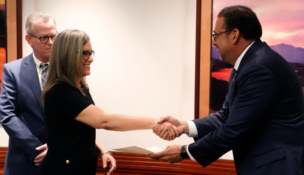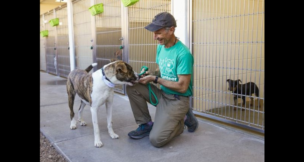Napolitano versus the Mexican cartels
Arizona Capitol Reports Staff//March 27, 2009//[read_meter]
U.S. Homeland Security Secretary Janet Napolitano outlined the Obama administration’s plans for fighting Mexican drug cartels and reducing the violence that has plagued America’s southern border.
The plan was unveiled at a time when Mexican border cities are seeing a major upswing in the level of violence. Open-air shootouts between factions of rival drug traffickers have erupted during daylight hours in cities such as Tijuana, Juarez and Nogales, a frequent destination for Arizonans.
“Our goal is two-fold. One is to provide assistance to the government of Mexico, to break up these huge cartels which are funneling tonnage quantities of illegal drugs into our country on a regular basis and are conducting this war of violence in Mexico that has resulted in over 6,000 homicides, over 550 of which were assassinations of law enforcement and public official personnel,” the former Arizona governor said at a White House press conference on March 24. “The second is to guard against an increase in violence in the United States as a result of the actions undertaken in Mexico.”
The plan will include doubling law enforcement teams known as Border Enforcement Security Task Forces at the U.S.-Mexico border, as well as stepping up efforts to interdict firearms being smuggled into Mexico, tripling the number of Department of Homeland Security intelligence analysts in the border region, and strengthening efforts to stop the flow of cartel money from the U.S. into Mexico.
Deputy U.S. Attorney General David Ogden said DHS and the Department of Justice are taking a comprehensive approach to fighting the cartels, which he compared to the government’s battle against La Cosa Nostra, as the mafia is known. Through those efforts, he said, the mafia has been effectively dismantled and many of its senior leaders are in prison.
“For more than a quarter century, U.S. law enforcement agencies have recognized that the best way to fight the most sophisticated criminal enterprises is through intelligence-based investigations to target the greatest threats,” Ogden said. “As we’ve found with other large criminal groups, if you take their money and lock up their leaders, you can loosen their grips on the vast organizations that are used to carry out their criminal activities.”
Under a program known as the Merida Initiative, the U.S. will invest $700 million this year to improve law enforcement on the Mexican side of the border, an effort that will include new inspection technology for Mexican law enforcement personnel, technology that will allow secure communications between Mexican officials, five helicopters for the Mexican Army and Air Force, as well as surveillance aircraft for the Mexican Navy, and assistance in helping Mexican prosecutors develop effective victim- and witness-protection programs.
At the press conference, Napolitano addressed recent requests from states for the federal government to use additional National Guard soldiers to combat cross-border violence. On March 11, Arizona Gov. Jan Brewer sent a letter to Defense Secretary Robert Gates, asking for 400 Army and Air National Guard personnel on the border.
Napolitano said the government is still considering that option, and said she will meet next week with Texas Gov. Rick Perry to discuss the issue. She did not mention the request of her successor, Brewer.
Following the unveiling of the plan, Brewer released a statement saying that the additional National Guard troops she requested could augment Obama’s and Napolitano’s plan, and urged more federal funding to help border states and local law enforcement in their fight against border violence.
“While shifting and redeploying current and existing resources is a good first step, it is more important that border states, local law enforcement, and tribal law enforcement receive a surge in additional federal funding and additional resources to respond to the clearly increased threat of violence and kidnappings,” according to Brewer’s statement. “As governor of the state of Arizona, I have no higher priority than the safety and security of our citizens, and I am certain that President Obama, Secretary Gates, and Secretary Napolitano (as a former border governor) share that priority.”
When questioned on whether people in border states such as Texas would view the surge of law enforcement and federal personnel as modest and incremental, Napolitano said the plan calls for a “very robust movement of personnel.”
“DHS alone, it’s 350 specifically dedicated to cartel (opposition), in addition to what we already had moved there,” she said. The plan also includes the movement of 100 agents from the Bureau of Alcohol, Tobacco and Firearms to the border in the next 45 days.
The plan also includes stepped up efforts by the Drug Enforcement Agency as well, which said it intends to fill 16 new positions in its Southwest border field divisions. Right now, 1,171 agents are allocated to those divisions.
Napolitano also said fighting the cartels in Mexico will reduce cross-border violence they create in U.S. cities such as Phoenix and Houston. Arizona has experienced a rash of cartel-related violence, leading some to dub Phoenix the kidnapping capital of America.
“What we want to do is to better secure the border area against further violence and make it a safe and secure area where, of course, the rule of law is upheld and enforced,” she said.
In a conference call following the press conference, Dan Restrepo, director of Western Hemisphere Affairs for the National Security Council, said a key component of the agreement is cooperation at all governmental levels between the United States and Mexico. He noted that the only world leader whom Obama met with as president-elect was Mexican President Felipe Calderon, whom Restrepo praised for his “courageous” efforts in battling the cartels. He also mentioned that Napolitano, Secretary of State Hillary Clinton, Attorney General Eric Holder, Joint Chiefs of Staff Chairman Adm. Mike Mullen, Gates and Obama will all visit Mexico in the next several weeks.
“The U.S.-Mexico relationship at the Southwest border implicates pieces of the government that need to be coordinated at the federal level, and then obviously with state and local officials. That effort is a dynamic one. It’s one that is ongoing. We have the invaluable insights that Secretary Napolitano brings to this as a former border governor. So, yes, this will be a dynamic response and will be adjusted as we go along, as circumstances require.”
Restrepo also said the plan included efforts to reduce demand in the U.S. for the drugs that fuel the cartels. Those efforts will include using federal stimulus money to fund drug court programs in the U.S., which he said have been highly successful in reducing recidivism.

















